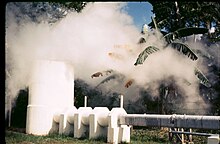| Tiwi Geothermal Power Plant | |
|---|---|
 | |
 | |
| Country | Philippines |
| Location | Albay, Philippines |
| Coordinates | 13°27′56.5″N 123°38′58.1″E / 13.465694°N 123.649472°E |
| Status | Operational |
| Commission date | 1979 |
| Owner(s) | AP Renewables |
| Operator(s) | AP Renewables |
| Geothermal power station | |
| Type | Flash steam (existing) / Binary cycle (planned) |
| Power generation | |
| Units operational | 4 units[1] |
| Units planned | 1 unit |
| Nameplate capacity | 234 MW |
The Tiwi Geothermal Power Plant is a 234-MW geothermal power station in Tiwi, Albay, Philippines.
History
[edit]
The Commission on Volcanology conducted an exploration of the Tiwi geothermal field from 1964 to 1968.[2]
The Philippine government in early 1971 invited the Union Oil Company of California (Unocal) to form the Philippine Geothermal, Inc. (PGI) which is intended as a joint venture for the exploration and development of geothermal energy. A service contract was made with the state-owned National Power Corporation (NPC) on September 10, 1971.
PGI contributed technical knowledge as well as a portion of the Tiwi field's exploration and development. NPC would construct and run the geothermal power stations. The first two units were put into service in 1979. Units 3 through 6 would be operational from 1980 to 1982.[2]
The geothermal field would then be acquired by Aboitiz Power in 2009.[3][4] The company would own and operate the plant under its subsidiary AP Renewables.[5]
In January 2023, a new binary cycle power plant within the Tiwi Geothermal Power Plant broke ground. It will add 17-MW capacity to the existing geothermal complex.[6]
Facilities
[edit]The Tiwi Geothermal Field is divided into four geographical areas: Naglagbong, Kapipihan, Matalibong, and Bariis.[2] At one point it had six units and a 330-MW capacity.[7]
As of December 2021, the Tiwi geothermal facility has four units and a capacity of 234-MW.[1]
References
[edit]- ^ a b "List of Existing Power Plants (Grid-connected) as of December 2021" (PDF). Department of Energy. Retrieved April 9, 2023.
- ^ a b c "Tiwi". National Geothermal Association of the Philippines. Retrieved April 9, 2023.
- ^ Gatdula, Donnabelle (July 31, 2008). "Aboitiz group bags Tiwi-Makban power complex with $447-M bid". ABS-CBN News. Retrieved April 9, 2023.
- ^ Gatdula, Donnabelle (October 2, 2009). "Aboitiz Power pays full P12.12 billion for Tiwi-Makban". The Philippine Star. Retrieved April 9, 2023.
- ^ Macapagal, Jed (January 29, 2023). "Powering up communities for cleaner, better future". Malaya Business Insights. Retrieved April 9, 2023.
- ^ "AboitizPower expects 17 MW more from Tiwi geothermal". BusinessWorld. January 17, 2023. Retrieved April 9, 2023.
- ^ "Tiwi Geothermal Power Plant Complex Rehabilitation Project" (PDF). Archived (PDF) from the original on March 8, 2012. Retrieved March 24, 2011.
Well, that’s interesting to know that Psilotum nudum are known as whisk ferns. Psilotum nudum is the commoner species of the two. While the P. flaccidum is a rare species and is found in the tropical islands. Both the species are usually epiphytic in habit and grow upon tree ferns. These species may also be terrestrial and grow in humus or in the crevices of the rocks.
View the detailed Guide of Psilotum nudum: Detailed Study Of Psilotum Nudum (Whisk Fern), Classification, Anatomy, Reproduction